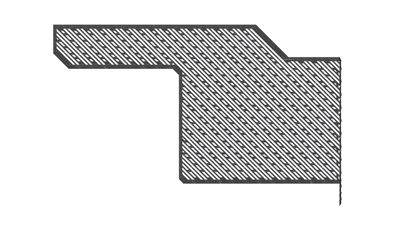The parking garage is a starkly utilitarian typology that has been an unlikely subject for some of the world’s highest-profile architects; everyone from Frank Gehry to Herzog and de Meuron has tried their hands at a high-design car park. Now, New York–based computational design and digital fabrication studio MARC FORNES / THEVERYMANY has brought a designer parking garage to Charlotte, North Carolina, with Wanderwall, an exterior parkade wall of fluorescent aluminum.
The blue-green aluminum screen spans eight stories; its pattern—reminiscent of Van Gogh’s Starry Night—takes on a dreamy quality as it courses across the east and south elevations of the structure. According to MARC FORNES / THEVERMANY, the facade’s design evokes Charlotte’s status as the second largest financial center in the nation; the aluminum sheets are punctuated by a network of nodes strung together by a web of striations passing over waves of diagonal ridges.

The thickness of the aluminum screen is 1/8 inch while the depth of the overall surface reaches up to 16 inches at certain moments. Light passing through nodes and striations of the facade, which is reminiscent of an Arabic mashrabiya window oriel with its complex geometrical latticework, casts varied shadow patterns on the otherwise drab interior concrete walls and flooring. Additionally, the folds of the aluminum reflect sunlight to create a glowing fog of light.
Although composed of 5,768 individual aluminum pieces, the facade is draped over the structure as a continuous piece without the backing of a secondary structure and is attached directly to the main concrete structure.
“There is no discrete secondary structure, but rather, the facade is a unified system which provides both structural depth, enclosure, and a graphic signal at the urban scale” said MARC FORNES / THEVERYMANY, “it is composed out of labyrinthine stripes, a continuous diagonal underlayer, and custom brackets—all made out of cut and folded aluminum. No one part works independently—only in collaboration with the other parts.”

The pattern of the facade emerges from the flow of dramatic colors through a rational grid. “The overall motif is derived from computational flows, captured at one moment in the simulation,” said the design team. “Those resulting curves are approximated through sets of non-linear, labyrinthine stripes. Coloration is applied in relation to the ‘viscosity’ of the initial flows.”
While this is one of MARC FORNES / THEVERYMANY’s larger projects, the design team noted that the scaling up of the ultra-thin aluminum system the firm has used in smaller projects was easier than anticipated. Lessons learned from past permanent projects—such as engineering techniques and workflows—serving as an effective guide.
Marc Fornes will be presenting a detailed dive into Wanderwall at Facades+ Charlotte on March 19.














